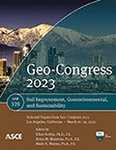Hydraulic Conductivity of Soil with Poly-Vinyl Alcohol (PVA)
Publication: Geo-Congress 2023
ABSTRACT
Due to the changing climate, the rainfall duration and intensity increase each year. Especially in urban areas, the increased impervious surfaces (roofs, pavements) augment the surface runoff. Therefore, it is desirable to examine ways of increasing the soil hydraulic conductivity in a controlled manner and of reducing the runoff. In this study, we investigate the impact of the poly-vinyl alcohol (PVA) on soil hydraulic conductivity. The examined soil is poorly graded sand with clay (SP-SC). We use mixtures with 3% and 10 % PVA and employ a field test method for the measurements. We examine the suitability of the method for our measurements. The trends of the hydraulic conductivity observed match those found in literature for soil without PVA. Our preliminary results show that although the PVA does not significantly increase the overall soil’s hydraulic conductivity, that is the ability of water to pass through soil, the hydraulic conductivity increases at the early stages of the PVA’s dissolution.
Get full access to this article
View all available purchase options and get full access to this chapter.
REFERENCES
Abdul, I. (2014). “Effects of Poly Vinyl Alcohol/Starch as Soil Conditioners on the Physical Properties of Loamy Sand and Loam Soils Following Different Wetting and Drying Cycles.” Jn. of Natural Sciences Research, 4(24), 36–41.
Ajayi, A. E., and Horn, R. (2017). “Biochar-Induced Changes in Soil Resilience: Effects of Soil Texture and Biochar Dosage.” Pedosphere, 27(2), 236–247.
ASTM. (2016a) Standard Test Methods for Measurement of Hydraulic Conductivity of Saturated Porous Materials Using a Flexible Wall Permeameter, Standard ASTM-5084, ASTM International, West Conshohocken, PA.
Bagarello, V., Iovino, M., and Elrick, D. (2004). “A Simplified Falling-Head Technique for Rapid Determination of Field-Saturated Hydraulic Conductivity.” Soil Science Society of America Jn., 68, 66–73.
Behnhood, A. (2018). “Soil and Clay Stabilization with Calcium-and Non-calcium-based Additives: A State-Of-the-Art Review of Challenges, Approaches and Techniques.” Transportation Geotechnics, 14–32.
Choi, S.-G., Wang, K., and Chu, J. (2016). “Properties of Biocemented, Fiber Reinforced Sand.” Construction and Building Materials,120, 623–629.
Cuisinier, O., Auriol, J.-C., Le Borgne, T., and Deneele, D. (2011). “Microstructure and Hydraulic Conductivity of a Compacted Lime-treated Soil.” Engineering Geology, 123, 187–193.
De Campos, A., Marconato, J. C., and Martins-Franchetti, S. M. (2011). “Biodegradation of Blend Films PVA/PVC, PVA/PCL in Soil and Soil with Landfill Leachate.” Brazilian Archives of Biology and Technology, 54(6), 1367–1378.
Di Matteo, L., Bulletti, L., Capecchi, E., and La Viola, A. (2020). “Perspectives of Using Lignin as Additive to Improve the Permeability of In-Situ Soils for Barrier Materials in Landfills.” Sustainability, 12, 1–14.
Elrick, D. E., and Reynolds, W. D. (1992a). “Methods of Analyzing Constant-head Well Permeameter Data.” Soil Science Society of America Journal, 56, 320–323.
Guo, G., Zhou, Q., and Ma, L. Q. (2006). “Availability and Assessment of Fixing Additives for the In-situ Remediation of Heavy Metal Contaminated Soils: A Review.” Env. Monitoring and Assessment, 116, 513–528.
Ma, C., Li, J., Xia, W., Ding, Y., Zhang, L., and Xu, Y. (2022). “Effect of Additives on the Remediation of Arsenic and Chromium Co-contaminated Soil by an Electrokinetic-permeable Reactive Barrier.” Env. Science and Pollution Research, 29, 11966–11975.
Mitchell, J. K., and Soga, K. (2005). Fundamentals of Soil Behavior, 3rd Edition, John Wiley & Sons, Hoboken, N.J.
Park, S.-S. (2009). “Effect of Fiber Reinforcement and Distribution on Unconfined Compressive Strength of Fiber-Reinforced Cemented Sand.” Geotextiles and Geomembranes, 27(2), 162–166.
Shaheen, S. M., Hooda, P. S., and Tsalidas, C. D. (2014). “Opportunities and Challenges in the Use of Caol Fly Ash for Soil Improvements -A Review,” Jn. of Environmental Science, 145, 249–267.
Vergani, C., and Graf, F. (2015). “Soil Permeability, Aggregate Stability and Root Growth: A Pot Experiment from a Soil Bioengineering Perspective.” Ecohydrology, 9(5), 830–842.
Information & Authors
Information
Published In
History
Published online: Mar 23, 2023
Authors
Metrics & Citations
Metrics
Citations
Download citation
If you have the appropriate software installed, you can download article citation data to the citation manager of your choice. Simply select your manager software from the list below and click Download.
